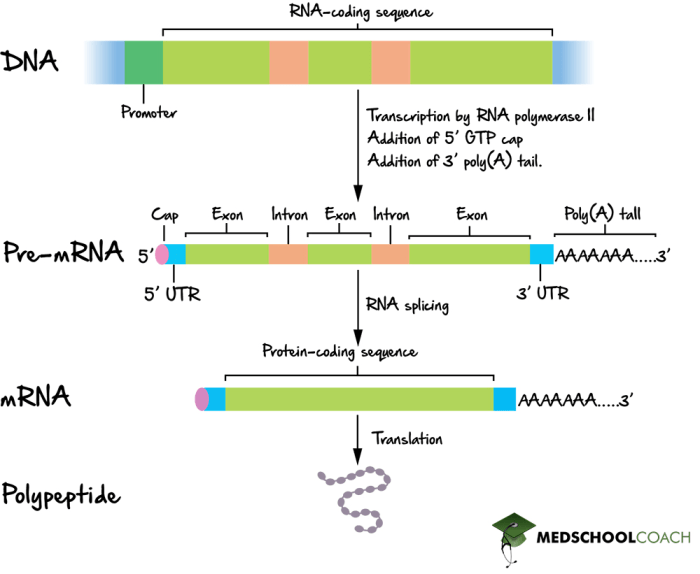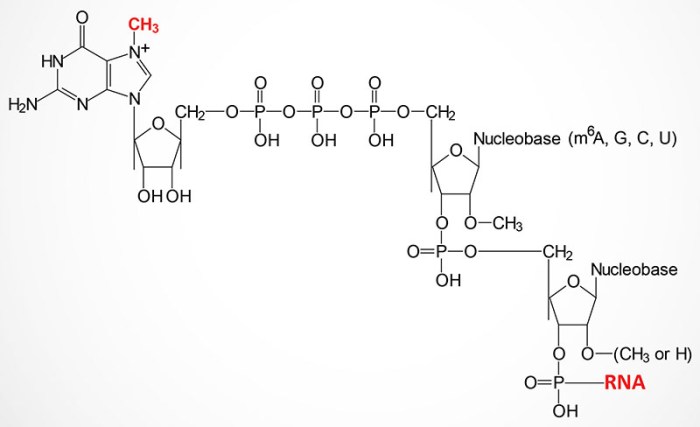Which of the following statements about eukaryotic mRNA is true? This question delves into the fundamental aspects of eukaryotic mRNA, exploring its structure, processing, and function within the complex cellular machinery. Eukaryotic mRNA, a critical intermediary in gene expression, holds the blueprint for protein synthesis and plays a pivotal role in regulating cellular processes.
This article provides a comprehensive overview of eukaryotic mRNA, unraveling its intricate molecular mechanisms and highlighting its significance in cellular biology.
Eukaryotic mRNA, unlike its prokaryotic counterpart, exhibits a unique structural organization. It comprises a 5′ cap, 5′ untranslated region (UTR), coding sequence, 3′ UTR, and a 3′ poly(A) tail. These distinct regions contribute to mRNA stability, translation efficiency, and cellular localization.
The processing of eukaryotic mRNA involves a series of meticulously orchestrated steps, including transcription, splicing, and polyadenylation. These processes ensure the removal of non-coding sequences (introns) and the addition of essential structural elements, ultimately generating a mature mRNA molecule ready for translation.
Structure of Eukaryotic mRNA

Eukaryotic mRNA has a distinct structure that enables it to carry genetic information from the nucleus to the ribosomes for protein synthesis. It consists of several key regions:
- 5′ Cap:A modified guanine nucleotide added to the 5′ end of mRNA. It protects the mRNA from degradation and facilitates its binding to ribosomes.
- 5′ Untranslated Region (UTR):A non-coding region located between the 5′ cap and the start codon. It contains regulatory elements that influence mRNA stability and translation.
- Coding Sequence:The region of mRNA that contains the genetic code for protein synthesis. It consists of codons, which are three-nucleotide sequences that specify the amino acid sequence of the protein.
- 3′ Untranslated Region (UTR):A non-coding region located between the stop codon and the 3′ poly(A) tail. It contains regulatory elements that influence mRNA stability and localization.
- 3′ Poly(A) Tail:A sequence of adenine nucleotides added to the 3′ end of mRNA. It protects the mRNA from degradation and enhances its translation efficiency.
Processing of Eukaryotic mRNA: Which Of The Following Statements About Eukaryotic Mrna Is True

Eukaryotic mRNA undergoes a series of processing steps before it becomes functional:
Transcription
Eukaryotic mRNA is initially transcribed from DNA in the nucleus by RNA polymerase II. The primary transcript, known as pre-mRNA, contains both coding and non-coding sequences.
Splicing
Pre-mRNA undergoes splicing, a process that removes non-coding sequences (introns) and joins the coding sequences (exons) together. This results in the formation of mature mRNA.
Polyadenylation
After splicing, a poly(A) tail is added to the 3′ end of the mRNA. This tail protects the mRNA from degradation and enhances its translation efficiency.
Translation of Eukaryotic mRNA

Translation is the process by which mRNA is decoded to produce a protein:
Initiation, Which of the following statements about eukaryotic mrna is true
Translation begins with the binding of the small ribosomal subunit to the 5′ cap of mRNA. The tRNA carrying the initiator amino acid (usually methionine) binds to the start codon (AUG) on mRNA.
Elongation
The large ribosomal subunit joins the complex, and the ribosome moves along the mRNA, codon by codon. Each codon is recognized by a specific tRNA carrying the corresponding amino acid. The amino acids are linked together to form a growing polypeptide chain.
Termination
Translation continues until a stop codon (UAA, UAG, or UGA) is encountered. The ribosome releases the polypeptide chain and dissociates from the mRNA.
User Queries
What is the primary function of eukaryotic mRNA?
Eukaryotic mRNA serves as the template for protein synthesis, carrying the genetic code from DNA to the ribosome, where it is translated into a chain of amino acids.
How does the structure of eukaryotic mRNA differ from prokaryotic mRNA?
Eukaryotic mRNA possesses a more complex structure, including a 5′ cap, 5′ UTR, 3′ UTR, and a 3′ poly(A) tail, which contribute to its stability, translation efficiency, and cellular localization.
What is the significance of mRNA processing in eukaryotes?
mRNA processing, involving splicing and polyadenylation, removes non-coding sequences (introns) and adds essential structural elements, ensuring the production of a mature mRNA molecule ready for translation.